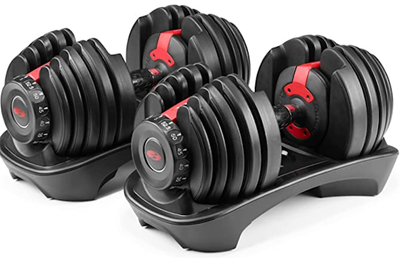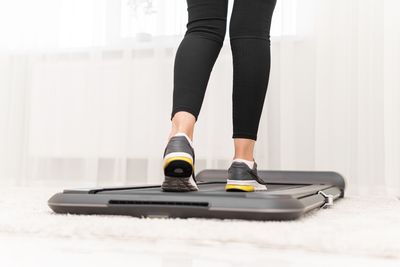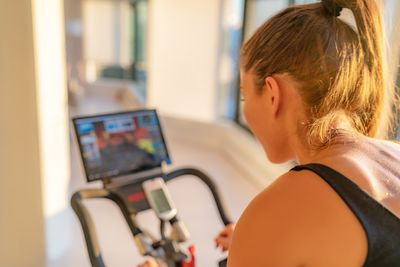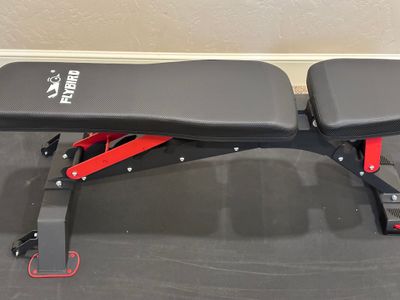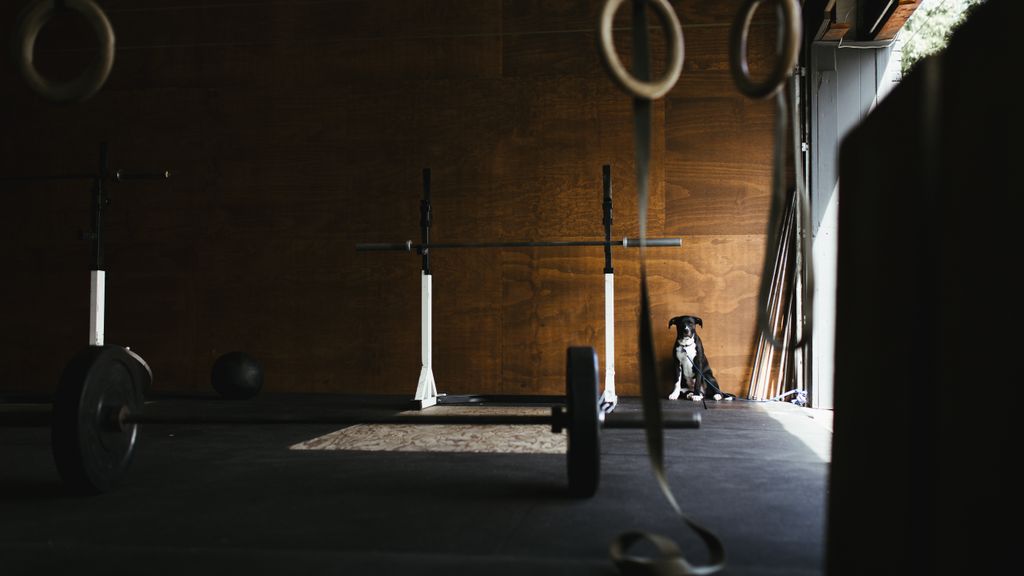
Benefits of a Powerlifting Home Gym
Powerlifting workouts are long due to the extensive rest times required between sets for heavy strength sessions.
Because of this, powerlifting in a commercial gym can be tedious.
Most big box gyms have precious few power racks or squat racks and even fewer deadlift platforms and adjustable bench presses.
Access to adjustable specialty equipment is crucial for powerlifters, as a poor walkout on a heavy squat or a poor handoff on the bench press can have catastrophic consequences at extremely heavy loads.
It's also super annoying to try to find a squat rack in a busy gym or be pestered by other gym members wondering how many sets you have left.
Get our fitness newsletter
Stay on track with your fitness goals and get inspired! Sign up for the GymBird newsletter for twice-monthly expert fitness and nutrition tips.
Convenience and Accessibility
In addition to the practical restraints powerlifters face when accessing equipment, most big box gyms aren't exactly friendly to their powerlifting clientele. Whether it's rules against gym bags, lifting chalk, or dropping the weights–powerlifters aren't usually accommodated well.
Investing in a home gym makes sense because it offers a more convenient and accessible training experience. A home gym enables you to skip waiting in line for equipment, and you can choose to invest in specialty strength equipment only found in powerlifting gyms too.
You also get to control the temperature and the training atmosphere. Do you want the A/C blasting? No problem. Do you want your death metal playing on max volume? This is your rodeo.
Long-Term Cost Savings
Depending on which pieces of equipment you decide to invest in and how comfortable you are with DIY projects, home gyms can even be a cheaper option long-term.
You can take many cost-cutting measures to provide an excellent powerlifting home gym experience without breaking the bank. More on those later.
Choosing the Right Location for Your Home Gym
There are many things to consider when staking out your home gym location, such as your available space, noise considerations, and ventilation and temperature control. Many people house their gym in their garage, but that has downsides.
Evaluating Your Equipment Needs
You may only have one area in your home that's available. But if you own your home, you likely have a few choices. Carefully evaluate your equipment minimums and measure the potential spaces to ensure it will fit with room to maneuver around it.
You must reevaluate your necessary equipment if you can't find space to fit it.
Noise and Flooring Considerations
Next, you must understand the flooring limitations of the room while considering your equipment wish list.
If you plan to invest in a deadlift platform, your floor type is less critical but should still be evaluated. Powerlifting, and deadlifting in particular, is very loud and brutal on flooring.
This can result in noise complaints from neighbors and serious damage if you aren’t prepared, so make sure your floor can handle it and invest in a platform or serious matting.
Ventilation and Temperature Control
Another key consideration when scoping out locations for your home gym is the room's ventilation and temperature.
While garage gyms are popular due to their durable cement flooring, most garages aren't well-ventilated or temperature-controlled. This can lead to freezing sessions in the winter and broiling workouts in the summer, depending on where you live.
Essential Powerlifting Home Gym Equipment
The non-negotiable equipment for a powerlifting gym will facilitate your big three lifts: the squat, bench, and deadlift.
Additional equipment that's great for accessory lifts or specialty movements can be invested in slowly over time, but you must have a power rack/ squat rack, an adjustable bench (see the best workout bench for your home), and barbells and weights at a bare minimum.
Power Rack/Squat Stand
The squat is known as the king of all exercises, and your power rack should reflect that.
You have two options for your home gym squat setup: a power rack and a squat stand.
A power rack–sometimes called a cage–is a four-post metal setup that includes many holes for the safety bars and J-hooks (what the barbell rests on) that can each be adjusted for your height.
Power racks also have support bars at the top of the structure that are great for pull-ups and other accessory lifts.
A squat stand is a simpler variation on the power rack with just two metal posts and J-hooks. I strongly recommend a power rack over a squat stand for your home gym for a few reasons.
First, a power rack can be fitted with safety bars, which can save you if you fail a squat rep and also save your floors. Additionally, power racks can be outfitted for benching. This alone makes the power rack the superior choice for home gyms where you'll likely be lifting alone.
Second, power racks are versatile and have many uses, ideal for a home gym with limited space.
Bench
Your next essential powerlifting home gym investment should be a bench press setup of some kind. Now, you can invest in a full competition bench setup if you have the space and money or go with a simple flat bench.
The most important considerations for evaluating flat benches are their height, width, and padding options.
A too-tall bench will prevent you from using your arch positioning and rob you of leg drive. A bench that is too narrow will prevent you from locking in your 'shelf' during your bench setup.
And bench padding primarily comes down to your personal preference and comfort.
Benches come in various textures and coverings, from leather to plastic, and are stuffed with different padding densities.
Barbell and Plates
You have many more options for your barbell and weight plates.
Multiple legacy barbell companies exist, including Texas Power Bar, Rogue, and Vulcan.
Barbells come in many shapes and sizes in powerlifting, each with a unique purpose in your powerlifting program.
A traditional Olympic weightlifting barbell is considered the standard at 45 lb and 7 feet long. You'll use this bar type in most of your training and in competition.
The choice you need to make before you buy your first barbell is how much knurling you want the bar to have.
Knurling is the cross-hatching pattern that gets cut into the barbell where you grip the bar, providing superior grip while lifting.
Knurling exists on a continuum and varies by how sharp and significant the tiny ridges feel. Some bars have knurling that is so sharp it can cut into your back or hands while lifting.
You have even more options when buying weights to load your barbell. First, decide whether you want traditional steel or bumper plates.
Steel plates are coated and highly durable but can damage the floor if dropped.
Bumper plates usually come in multiple colors and are rubberized, making them the better home gym choice. That's because they're much safer for floors, quieter when dropped, and can be used for other strength lifts such as Olympic weightlifting.
Weight Collars, aka Spring Clips, aka Weight Clips
Whatever you want to call them, you need to invest in a pair of weight collars that will keep your weights firmly positioned on your barbell throughout the workout. These are sometimes referred to as spring clips or weight clips. These are non-negotiable for safety, and thankfully, they're cheap too.
Deadlift platform
This one is technically not required, but I strongly recommend it.
While you certainly can use a few pads stacked up to absorb the shock, a well-made platform will protect your floor and the weights.
Many platforms also have additional benefits, like band pegs for speed pulls.
Suppose you want a lifting platform but don't want to shell out for a professional one. In that case, you can actually make your own fairly easily.
Bonus Powerlifting Home Gym Equipment
The following equipment types aren't required but can speed up your strength and hypertrophy gains in your pursuit of powerlifting glory. Or they can simply make your powerlifting workouts more enjoyable and varied.
Dumbbells
If you've built out a basic powerlifting home gym and want to add something that will significantly impact your progress, dumbbells are the next item on the list.
Now, you could shell out for a traditional set of dumbbells, but that wouldn't be space-efficient, and it's expensive.
Instead, opt for adjustable dumbbells, which offer multiple weight sets in one compact pair.
>>> Also, see our favorite budget adjustable dumbbells
Weight Lifting Chalk
If you want to get kicked out of a commercial gym fast, bring your own chalk and let it fly. Understandably, commercial gyms typically outlaw chalk because it makes a mess. But one of the many benefits of a home gym is that you make the rules.
Lifting chalk is incredible for increasing grip, so give it a try. And if you don't want it everywhere, try liquid chalk instead.
Setting Up Your Home Powerlifting Gym: Layout and Design
You've decided to invest in an at-home powerlifting gym, and you're evaluating different companies and options, but what makes a great gym space anyway?
Gym Flow
I've worked out in dozens of gyms nationwide, and I'll share a few things that make a difference when creating a great workout space.
Inadequate Space Between Equipment
A common phenomenon that significantly impacts how comfortable you are in the gym is inadequate distance between the equipment.
Many gyms try to cram in as many pieces of equipment as possible, leaving the space feeling cramped and uncomfortable. It can even present a safety hazard if there aren't clear walking paths for people to navigate through.
Ensure at least two feet of space between each equipment station as a good rule of thumb.
Not Enough Space
As a powerlifter, your rack and platform will likely take up most of the space in your home gym. But make sure you at least have a yoga mat's worth of space for other activities like warming up, stretching, and core workouts.
Many old-school powerlifting dungeons I’ve trained in were so bare bones I didn’t even have a comfortable spot to warm up.
Mirrors and Lighting
Another element that makes a gym feel bigger and brighter is the amount of lighting and mirrors they have.
You'll notice that most commercial gyms have loads of mirrors and overhead lighting, and that's no accident. Mirrors are not only helpful for checking your form, but they also make any space feel much bigger. The same goes for ample lighting.
While you don't have to invest in floor-to-ceiling mirrors, a few well-placed throughout the room can have a big impact.
Safety Considerations for Your Home Gym
Powerlifters often train in groups or pairs because lifting with a spotter is safer. However, there are steps you can take to lift safely alone.
Spotter Arms and Weight Collars
Two non-negotiable items for a home powerlifting gym are spotter arms for your power rack and weight collars on your barbell.
Squatting heavy weights with a barbell carries risks, so you want to use all the safety measures available–especially when working out alone.
Spotter arms in the power rack are a no-brainer and can save your body and floors.
Spotter arms are the metal bars you can change the height on in your power rack. As the name implies, they are meant to be stand-ins for a workout spotter who could assist you in standing back up if you fail the lift.
You must set the spotter arms at the correct height, equal to the height of the bottom of your squat. So, if you need to bail, you can dump it off your back, and the arms will catch it.
Weight collars are also indispensable for powerlifting safety, no matter where you are lifting. They are particularly important for deadlifts as weight plates will wiggle around each time they hit the ground, knocking you off-balance and even causing injury.
Tips for Lifting Without a Spotter
Lifting without a spotter can be done safely, with a few considerations.
First and foremost, you need to know how to bail on a squat. Depending on the equipment you're working with, there are two safe ways to bail out of a squat.
If you squat without spotter arms, dump the weight backward, as demonstrated here.
Note you must use bumper plates if you intend to drop the weight like that.
If you're squatting with spotter arms, they must be set high enough to closely approximate the bottom of your squat. That way, if you have to bail, you can lower the bar in a controlled fashion toward the bar and then crawl out like this.
Do not let the weights carry you forward and hit you on the neck.
Resources Powerlifting in Your Home Gym
Best Apps for Powerlifting Coaching
Best Personalized Powerlifting Coaching
Best Free Powerlifting Programs
Best Powerlifting Book
Bottom Line
Creating a powerlifting home gym has many benefits and can give you an enjoyable space to work out, tailored to your needs and goals.
Your home gym should include a power rack or squat stand, a flat bench, a deadlift platform or mats to absorb shock, and a barbell and weights.
When designing your home gym, ensure you have at least two feet of space between each piece of equipment and evaluate your flooring to avoid damage to your home or your weights.
Always follow safety precautions when lifting alone, such as using spotter arms during the squat and learning how to bail from a lift correctly.
Powerlifting Home Gym FAQs
What are the essential equipment and accessories needed for a powerlifting home gym?
The bare-bones equipment for a powerlifting home gym includes the following:
- A power rack
- A bench
- A barbell and weights
- Deadlift platform or padding
What safety precautions should I take when powerlifting at home?
Make sure you evaluate your flooring before you buy equipment to prevent damage, know how to bail out of a lift if you're lifting alone, and lift with a training partner whenever possible.
How can I create a budget-friendly powerlifting home gym without compromising on quality?
You can save on your powerlifting home gym costs by purchasing only the minimum equipment, including a power rack, bench, barbell, and weights.
You can save on the cost of a deadlift platform by purchasing your own or by using inexpensive pads instead.
What are the advantages and disadvantages of powerlifting at home versus joining a commercial gym?
A powerlifting home gym gives you complete control over the equipment available, allows you to skip the line at busy commercial gyms, and allows you to control the temperature, music, and rules.
While numerous home gym advantages exist, the cost is the biggest downside.
Even with the most conservative estimates, a new powerlifting home gym may run you a few thousand dollars to build.
More Strength Training Advice from GymBird Experts
- Ultimate Guide to Strength Training
- Ultimate Kettlebell Strength Training Guide
- Optimal Strength Training Frequency
- Functional Strength Training Benefits
- Best Strength Training Exercises
- Resistance Band Strength Training
- Understanding Reps in Strength Training
- Ultimate Guide to Olympic Weight Lifting
- How to Start Powerlifting
- Bodybuilding Guide
